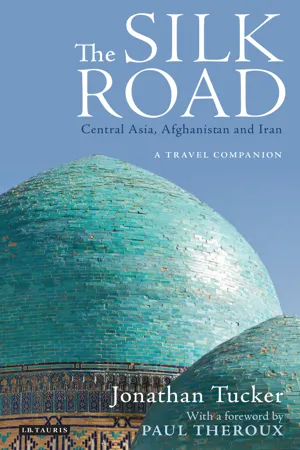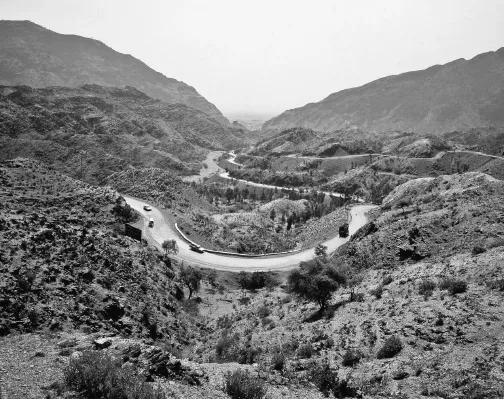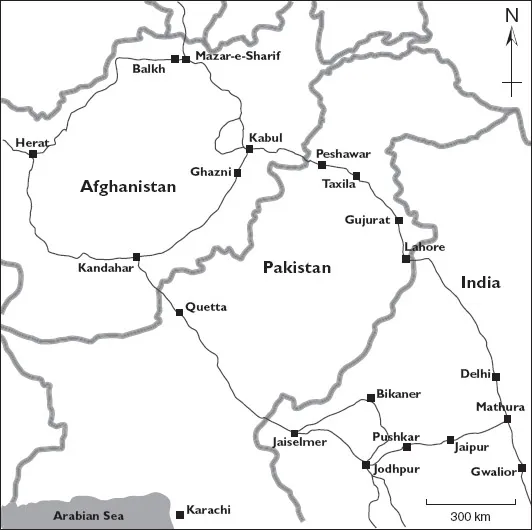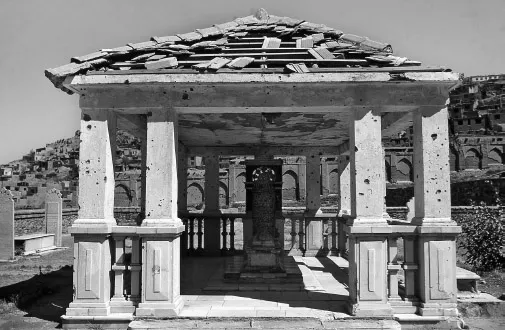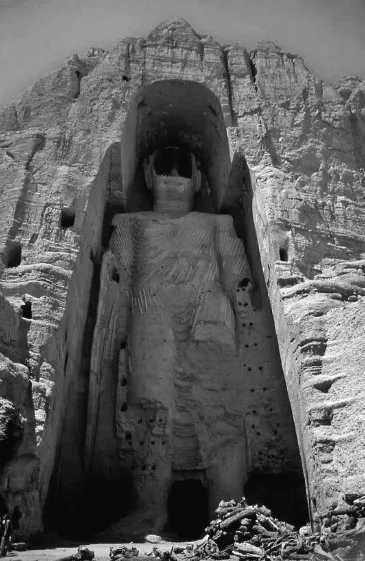![]()
CHAPTER ONE
The Old Road Through Afghanistan to India
For centuries the wealth of India flowed along a network of highways across the entire sub-continent. Many of the towns along the way and the merchants that controlled the commerce that passed through them became rich. Towns like Jaiselmer in western Rajasthan grew out of the desert-like mirages. The inhabitants profited from pan-Asian trade and built grand palaces (havelis) for themselves from local sandstone.
The principal trade route from India passed through Taxila, through the Khyber Pass to Bamiyan and across the Hindu Kush to Balkh. From Balkh, the highway led east along the Wakhan Corridor and through the Pamirs to China, or north to Termez and onwards to Central Asia. Bamiyan, itself some 2,500 m above sea level, was the approximate halfway point of an arduous journey across the country. At the eastern end of this part of the Silk Road is the Khyber Pass, rising through the foothills of the Slueman Range from its starting point, about 16 km west of Peshawar. The 45 km long pass has provided access to India since the beginnings of recorded history (Figure 1).
The pass also contains the western terminus of the Grand Trunk Road, a highway built by the British on the site of an ancient route that traversed the whole Indian sub-continent as far as Calcutta. The modern crossing point into Afghanistan is at Torkham, a bustling frontier post enlivened by characters who seem to come straight from the pages of Kipling.
During the Taliban era Silk Road trade was almost non-existent and consisted mainly of emergency food supplies sent into the country, and the scrap metal from thousands of shattered vehicles being sent out. The irony of the present conflict is that, in the years since the Twin Towers were attacked, Silk Road trade has revived – NATO vehicles now carry fuel and other supplies for US-led forces in Afghanistan and hundreds of lorries pass through Torkham in both directions each day.
Figure 1
The Khyber Pass, Pakistan.
The road from Torkham into Afghanistan passes through Jalalabad, once the site of innumerable Buddhist shrines and a place for pilgrimage. The technique of working in stucco, a cheap and readily available substitute for the grey schist stone favoured by the sculptors of Gandhara, attained its zenith around the third century at Hadda, near Jalalabad. Hadda’s numerous monasteries (viharas) were still active at the time of a visit by the Chinese pilgrim Fa Xian in around 400, but the city was ruined and desolate when Xuanzang passed through in 630 – wrecked by Hepthalite invaders. One of Hadda’s monasteries, Tapa-i-Shotor, escaped the ravages of the Hepthalites and until only a few years ago still contained large stucco sculptures of the Buddha flanked by attendants, with influences from the classical world.1 It did not survive the Taliban era, however, and today Tapa-i-Shotor consists of little more than a mound of earth and a few flakes of gold leaf.
MAP 2
The trade routes from India.
Kabul
Kabul has been Afghanistan’s capital for little more than 200 years but has been an important Silk Road entrepôt since at least as far back as the Kushan period (first century BC to fourth century AD). The old walls and the citadel (the Bala Hissar) date back to around the fifth century and, although they are much rebuilt and repaired, still present an impressive sight. Old guide-books about Afghanistan are now heart-rending to read. As late as 1977, Nancy Dupree wrote enthusiastically about the very features that drew early travellers to the city:
(N. H. Dupree, 1977)
There were periods of intense fighting for control of Kabul between 1992–6 and, at the end of it all, what remained was a travesty of the city she described (Figure 2).
Figure 2
Kabul, Afghanistan. August 2000.
After the fighting ended, large sections of Kabul lay in ruins and the monuments and grand buildings that once graced its streets were in large part no more. The National Museum, once home to some of the Silk Road’s greatest treasures, stood wrecked and roofless, its contents looted or destroyed.2 Above it all, on the slopes of a hill called Sher-Darwaza, the great Mughal emperor, Babur, lay in eternal repose in the gardens that he loved so much. After Babur’s death in 1530 his remains were brought to Kabul from Agra in fulfilment of his instructions, and he was laid to rest in a simple tomb. The fighting of the 1990s did not spare the tomb or the gardens and its appearance in 2000 was a metaphor on the impermanence of kingship and power (Figure 3).
Bamiyan
To the west of Kabul is the valley of Bamiyan, reached by two roads through the lower regions of the Hindu Kush, one passing through the Shibar Pass and the other via the Hajigak Pass. The Bamiyan valley sits on an ancient branch of the Silk Road that linked India with China. It flourished as a centre for trade and religious worship until 1221, when the area was attacked by the armies of Genghis Khan. Genghis’ favourite grandson Mütügen was killed during the siege of Shahr-I-Zohak (‘The Red City’), a fortress protecting the eastern entrance to the valley. In revenge Genghis ordered the complete destruction of the entire valley and the extirpation of every living creature. What remained was given the name Mobaliq (‘accursed city’). Shahr-I-Zohak still lies wrecked and abandoned above the valley, as does the nearby citadel of Shar-I -Gholghola (‘The City of Lamentations’), named for the screams of its inhabitants at the hands of the Mongols.
Figure 3
Babur: ‘A ruler from whose brow shone the Light of God’.3 The tomb of Babur (1483–1530), founder of the Mughal dynasty. Kabul, Afghanistan. August 2000.
The marble was badly damaged by bullets and the roof of the pavilion that covered it seemed ready to collapse but the park and buildings have since been rebuilt and crowds of visitors have now returned.
Two immense figures of Buddha, 55 m and 38 m in height, were hewn out of the rock at Bamiyan. They followed closely the Gandhara ideal and were probably carved by the pilgrims who travelled through the region and whose cave-sanctuaries can still be seen cut into the cliffs. The Buddhas were carved into the rock face of the cliff in a somewhat crude fashion and then covered, first with a layer of mud and then with a thinner layer of stucco, moulded to create garment folds. The immense Buddha images at Binglingsi, Longmen and Yungang in China may well have been inspired by the Bamiyan figures, and the monk Xuanzang’s description in about 630 captures the sense of awe with which they were regarded:
Figure 4
The Great Buddha, Bamiyan, Afghanistan, c. fifth century. Height 55 m. Photographed in August 2000. Destroyed by the Taliban in March 2001.
This immense image is probably a depiction of Vairocana, the cosmic Buddha. The alcove above the head was decorated with murals, and small monastic cells, chapels and assembly halls are cut into the rock.
(Xuanzang, 1884)
During the 1990s the entire Bamiyan valley was the scene of ferocious fighting between the Taliban and opposition groups. The Buddhas were damaged during these years but were not finally destroyed until March 2001, when they were blown up by the Taliban rulers of Afghanistan. In August 2000, when these photographs were taken, the larger of the two had not sustained major structural damage even though the upper part of the head had been blackened by the application of burning tyres (Figure 4). By then, the paintings that graced the caves at Bamiyan had already all but disappeared. Only the large roundels above the head of the large Buddha – neglected and flaking though they were – still remained and gave an idea of how beautiful the site must once have appeared.
The decorative elements and composition of these wall paintings, and those that once adorned the walls of the sanctuaries, are more Persian than Hellenistic. They reveal the new influences introduced to the area by the Sasanian invasions of the third century. Scholars have termed this new style of art ‘Irano-Buddhist’ or ‘Indo-Sasanian’. It reveals itself in the costumes and the decorative motifs of the Bamiyan paintings: apsaras (celestial nymphs) with flowing ribbons, jewelled diadems containing crescents and spheres, birds with strings of pearls in their beaks, and boar’s head medallions recall the Sasanian style but the faces of the figures are Indian. The paintings at Bamiyan are the antecedents of a style and technique found all over Central Asia. The pigments used at Bamiyan were mostly produced locally: ochre, sienna and lapis lazuli were the most popular, although imported indigo was also widely used. Wall surfaces were treated with a layer of clay mixed with vegetable fibres that was then coated with gypsum or plaster of Paris. Paint was then applied with a binding of animal glue.
The smaller of the two Buddhas, a slightly earlier creation dating to around the third century, stood about 400 m to the east and even by August 2000 had fared much worse than its companion. Even before the Taliban destroyed it, most of the local people’s enmity has been directed at this smaller image. There was an erroneous belief among them that the smaller image was female – a ‘lady Buddha’ as it were – and they were offended by its thin, clinging robes.
The picture is just as bleak in the Kakrak valley, just to the east. In 2000 a 6.5 m high Buddha still stood in a niche on the hillside, even though the paintings that once graced the caves had already gone; but this image, too, is now no more.
Through the ages, descriptions of the Buddhas of Bamiyan have ranged from the adulatory to the dismissive. Most, it must be said, are in the same vein as the awe-struck words of Xuanzang, quoted earlier. A number of observers were, however, less than impressed by the syncretic style that th...
